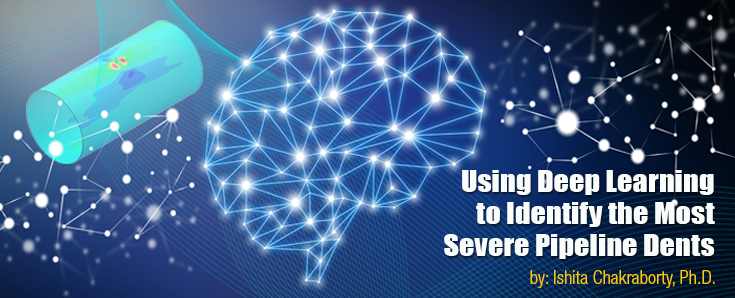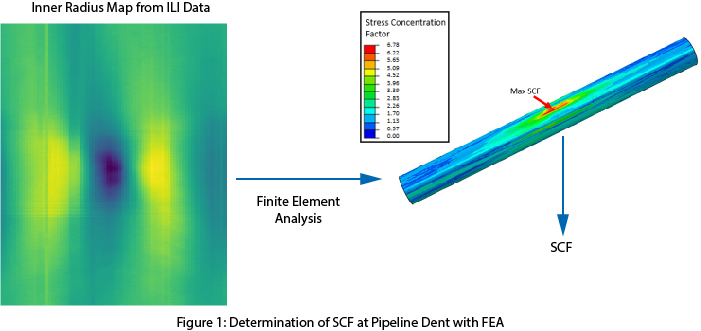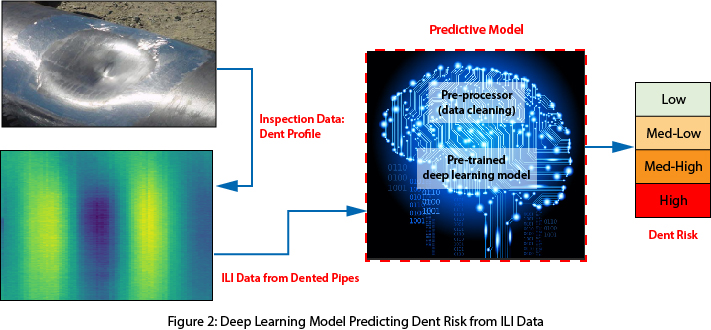Using Deep Learning to Identify the Most Severe Pipeline Dents

From facial recognition in mobile phones to self-driving cars, artificial intelligence and machine learning is changing everything. Machine learning has a huge potential to be used in asset integrity management to ensure operational safety. The purpose of this blog is to showcase an example where machine learning, combined with engineering domain knowledge, can determine the severity of dents in pipelines.
Artificial intelligence (AI) and machine learning (ML) are terms used interchangeably these days. However, ML is really a subset of AI. Deep learning is a type of machine learning that uses neural networks with multiple interconnected layers to learn from the data. The idea behind ML is that the computer is fed a large amount of data and it can predict useful information which it ‘learns’ from the data. Although the basic concepts of ML have been around for a long time, recent advances in computing and the availability of big data has turned ML into a very powerful tool. All ML-based models are founded on fundamental concepts of linear algebra, statistics and calculus. There can be several types of ML problems. For example, the pipeline dent identification problem has a labeled input where each dent may be labeled as a ‘high risk dent’ or a ‘low risk dent.’ These types of problems are known as ‘supervised learning’ as opposed to ‘unsupervised learning,’ where data are not labeled. Supervised learning can be of two types – ‘classification’ and ‘regression.’ Classification problems predict a class (for example dog images, cat images) and regression problems predict a numerical value (such as house price, temperature). Another important set of terminology in a ML application is ‘training data’ and ‘test data.’ The available data is randomly divided into these two sets, with the larger portion being the training data. The ML model is trained by feeding the computer the training data set. After the model is trained, it is tested on the test data, which the model has not seen before. This practice ensures that the model is not overly tuned to the data it is trained on – known as overfitting.

Coming back to pipeline dents, dents in pipelines are identified from in-line inspection (ILI) caliper data. The ILI data provides the inner radius map of a pipeline, which can identify the presence of a dent. The stress concentration factor (SCF) at the dent can be determined by conducting a finite element analysis (FEA) of a model built from the caliper data. The SCF associated with a dent is an important quantity since it is a measure of the increase of stress due to the dent as the pipe is in operation. A very high SCF can significantly reduce the fatigue life of a dented pipe. Figure 1 shows how ILI data is used in FEA to determine the SCF at a pipeline dent.
With the availability of a large amount of historical simulation results from ILI data, can machine learning be used to predict the dent severity from ILI data only? To answer this question, a deep neural network model is trained on a large data set of ILI data, of which the SCF is already known from FEA. The input to the model is the ILI data, which can also be thought as an image of the dented pipeline. The output is the risk associated with the dents: low, medium-low, medium-high and high. The risk categories are defined based on the value of SCFs. The model can predict the risk associated with a dent for a previously unseen test data set with an accuracy of approximately 95%. Use of data driven models such as the present one can significantly reduce the need for conducting a detailed finite element analysis to estimate the SCF. This fast and easy-to-use model can be deployed in real-time in an edge device or as a cloud-based service. Figure 2 shows the input and output data flow scheme. This AI enabled predictive model can predict the risk category of a dent in real time, even during the collection of data. It can be used as a ‘first pass’ dent assessment tool.

In the future, deep learning-based approaches can be further used to analyze raw data from ILI tools and classify potential anomalies, thus developing a standard frame work for all pipeline operators and ILI vendors.

Ishita Chakraborty, Ph.D. – Associate II, Houston Office
Ishita has been with Stress Engineering Services since 2014. With a core expertise in structural vibrations, she works in a variety of problems dealing with measured data; spanning upstream, midstream, and downstream areas. She combines machine learning with engineering expertise to solve complex problems.




Leave a Comment
You must Register or Login to post a comment.